We learned (thanks, Denny) that Arkady Shipunov passed away last week. He began work at Tula arsenal in 1950, and was chief designer of its instruments bureau from 1962 until 2006 – quite the long reign! He was a prodigious inventor whose work was mostly on large machine guns and missile systems, but he was also the co-designer of the GSh-18 (Gryazev-Shipunov) pistol developed by Tula in the late 1990s.
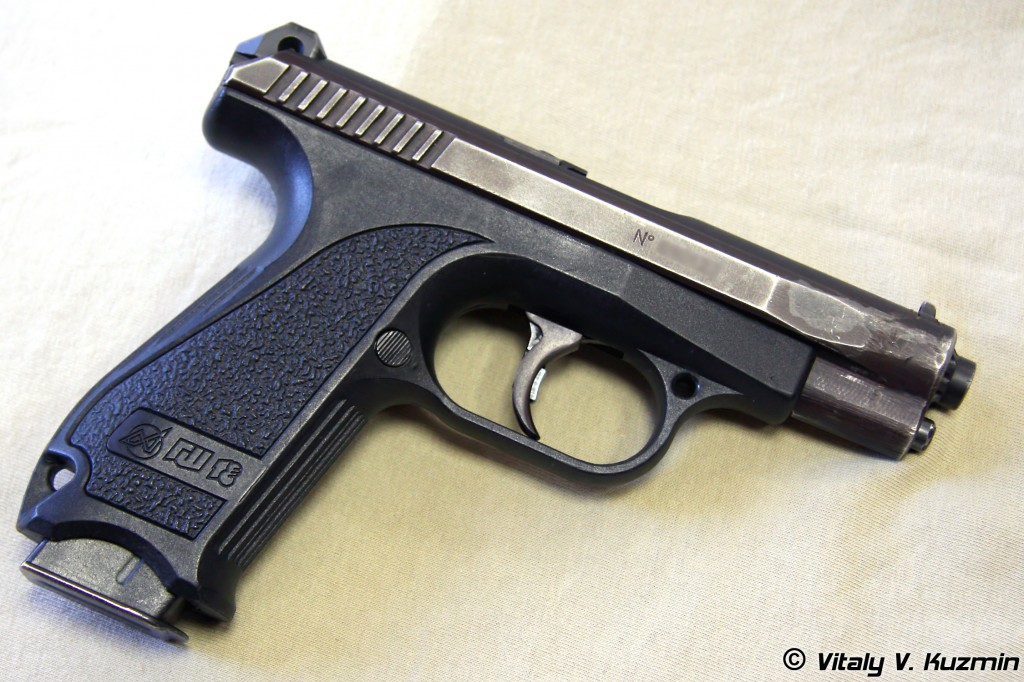
The GSh-18 is one of the more recent additions to the small fraternity of rotating-barrel handguns (see also: Roth-Steyr 1907, Obregon, CZ-24, Boberg XR9, and others). We haven’t had the chance to handle one ourselves, but the design is pretty interesting. While most rotating-barrel pistols use two or three lugs, the GSh-18 uses no less than ten, arrayed equally around the barrel. This gives the barrel a rotation arc of just 18 degrees, and gives it a very strong lockup with so much lug surface area.
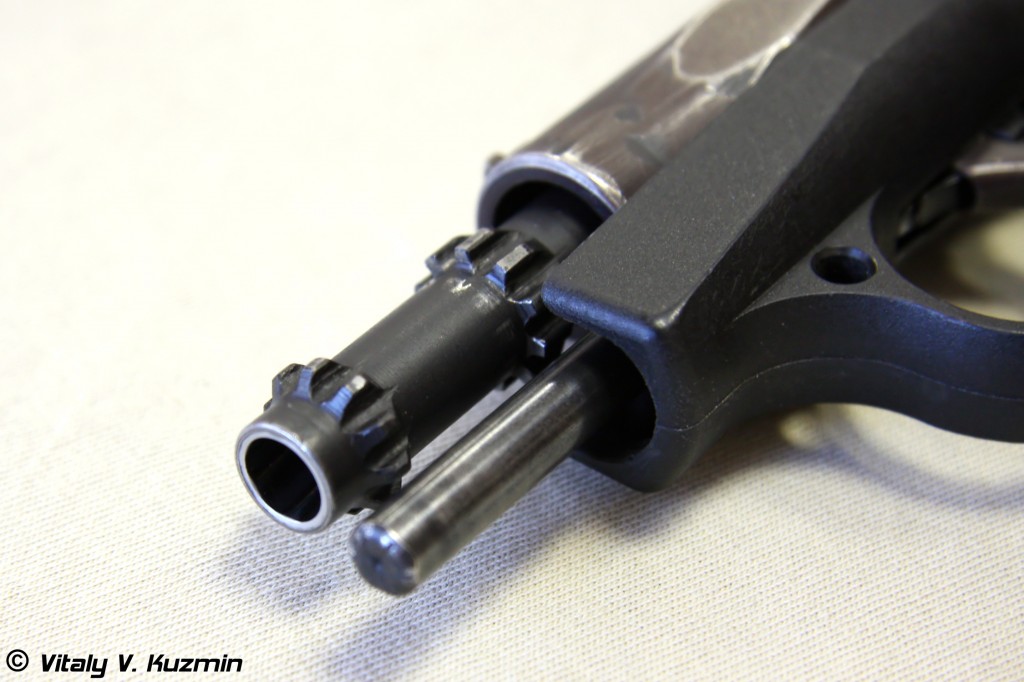
Details about the mechanism are a bit sketchy, but we suspect the beveled set of lugs just behind the barrel are intended to seal the slide against dirt and grime getting in and fouling the locking lugs. Despite the apparent vulnerability to dirt getting in, the pistol appears to have passed Russian military trials with flying colors. The GSh-18 on paper appears to be an excellent handgun:
- Good 3-dot sights (optionally including night sights)
- Nice low bore axis
- Polymer frame (for a total weight of just 16.5 ounces unloaded)
- Reversible mag release to accommodate left-handed shooters
- Trigger-mounted safety for simple loaded carry
- Ejector doubles as loaded chamber indicator
- 18+1 capacity of 9mm cartridges
In addition, the magazine of the GSh-18 is of the double-feed design, meaning that cartridges feed alternately from the left and right sides, instead of being forced into a single center column at the top of the magazine (the Stechkin APS also used double-feed magazines). This double-feed system has long been recognized as superior in submachine guns, as it reduces spring pressure on the cartridges, making for more reliable feeding and easier loading of magazines.
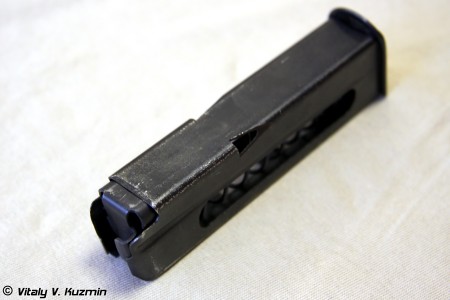
The one concern we have about the design – and again, this is without having actually handled one – is the rather complex disassembly. The design looks great on the outside, but it has a lot of independent parts that have to come out for basic takedown. Most other modern pistols have a nice modular construction, where the slide comes off as a complete unit with no fuss, but the GSh-18 requires several sequential parts to be removed.Connecting pins, non-captive springs…it’s just not very elegant:
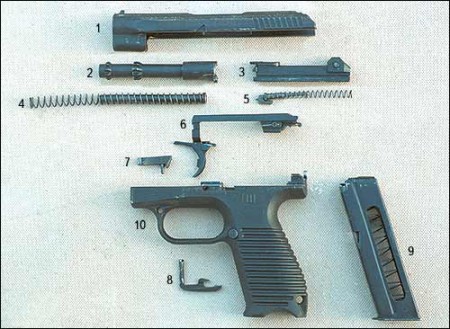
You can see a promotional video (in Russian) about the GSh-18 here, produced by Tula (where the guns were designed):
Now, there is another element to the GSh-18 that we need to talk about, and that is its ammunition. Apparently one of the design criteria for military service was armor penetration capability, and the GSh-18 was designed around a specific 9x19mm AP cartridge, designated 7N31. It operates at higher pressure than standard 9mm ball (roughly +P+ pressures, although Tula promo material would have you believe it’s higher), and throws a lightweight projectile at pretty high velocity. Specifically, a 65 grain hardened steel core bullet at 1970 fps, which will perforate NIJ Level III soft body armor, or 8mm of mild steel plate at close range. In today’s world of increasingly-standard use of good body armor by combat troops, that would seem like a reasonable requirement to have for a sidearm – although we do wonder how many combat troops would be wearing soft armor, rather than either rifle plates or no armor. However, the 7N31 case is outwardly identical to standard 9×19, so the pistol can be used with standard ammunition as well.
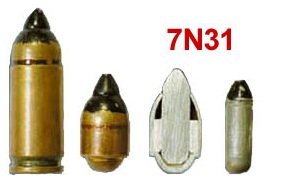
You can see a bunch more photos of the GSh-18 below, or download the whole set in high resolution as a zip archive:
[nggallery id=191]


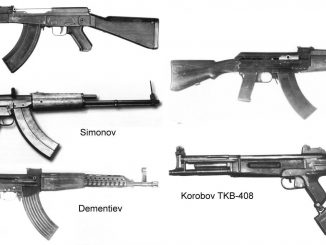
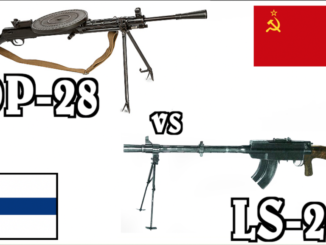
I am intrigued by this pistol. Is is possible that the front “lugs” serve as guides for barrel alignment when the pistol is in battery? Similar to the O-ring on and HK45 pistol?
It’s possible – as I said, I haven’t had a chance to actually handle one.
Dual-wielding.
Right.
Regarding the take-down (field stripping), they probably wanted to demonstrate by the picture that gun cosists out of only 16 individual parts. Most handguns have about 50 parts. I will try to find field-stripped gun picture.
Regarding the actual deployment, the information vary quite a bit. Some claim that several ‘hundreds’ were issues to Federal Security Bureau, but not much so far about military. Other news are saying that Russian military is poised to adopt Russo-Italian “Strizh” (Osprey) pistol.
In any case, whereas in the world we see predominance of Browning action, this comes as a refreshment.
My only question is “where can I get one?”
How many other pistols use double feed? It can’t be many… But I wish it were more.
The Steyr GB comes to mind, along with the guns Ian named. It’s a small group.
The Mauser c/96 and the Bergmann-Bayard are 2 more. Can’t recall any that have a magazine in the grip, though.
Any reason Tula can’t import these? I know there were some voluntary (?) restrictions on high cap rifles, but I don’t know if it covered handguns. Seems like this is big enough to meet all the required points for import.
My understanding is that Russian military arms have been banned from import by treaty for a while. We can get Saigas because they come into the US as civilian arms. I don’t know the details of the restrictions, but I expect there would need to be a “civilian” version of the pistol marketed in Russia, which would be unlikely given their restrictions on civilian handgun ownership. Alternatively, someone could license the design and start making them elsewhere to import into the US, I think.
Proliferation/ sales of firearms is interesting subject on its own; it touches quite intimately on politics. Foreign arms sold to civilians in U.S. are required to have some domestic contents, similarly in Russia. Not untill recently were Russians able to buy for example Glock. Now, when limited local production (or rather assembly) has started, they can. In same fashion, it would be logical to expect this firearm on sale in this part of the world. Somebody has to make the first step, I’d guess.
Denny, that’s a very interesting bit of information about the rules concerning gun ownership in Russia — and thanks for the great post on FW!
This was actually done all by Ian; I just suggested the topic since I had been long interested in this design. So in this crafty way I managed to stir discussion about it =))). Thanks for compliments anyway!
It bears a vague resemblance to the Caracal. I forget what system of operation the latter uses.
The Caracal is a browning-style I believe. I handled one and like it, but I heard they were recalled for some reason.
Someone in Pakistan had ka-boom with it; badly wounded, but survived. I read story written by his brother who was luckily around. Some suspect Chinese made ammo, pistol is probably sound.
Hi, Denny,
Caracal is really a good pistol and I have chased
the events you mentioned carefully. Unfortunatelly
the sole quilty is the pistol itself. It broke apart
into two clean parts with no harm seen on any other
members of the gun. Company recalled for return all
pistols in broken model of “C” type, but reduced
the content into a very limited brace of production
later and with no appearent positive action up to this
time. Full size “F” model seems sound and strong
enough but, it looks that company tried some different
manufacturing method for “C” models which might be
MIM process with its weigth being so close to upper
limit of this manufacturing method which is 250 grams.
Easiest way understanding this, is a simple metering
of material special density which is 7.7 grams per
cm3 for MIM Parts, and 7.8-7.85 grams per cm3 for
forged or investment cast types. This metering gives
no harm to any production parts and unfortunatelly,
not made up to this time.
Sorry, I have forgotten to mention that the part broken into two clean pieces was slide.
a very interesting gun.
I usually look at pictures before I read something properly – from the detachable breech bolt in the slide, I thought it was going to be a delayed blow back, rather than a locked breech.
It looks like a really well thought out pistol, the double feed position mag is a nice touch – so much easier to load,
and the dual mag catch cutouts on the mag box suggest the mag release can be changed across for left handers.
Thanks for sharing.
Some designs are like this (mentioned Caracal among them); with separate breech piece. I quess it makes sense for mfg purposes. On the other hand the slide is not as homogenous and connection between the two has to withstand shot’s force which may be bit of challenge.
16.5 ounces!? That’s the best part. The ammo would almost weigh as much as the pistol.
There are a handful of patents listed for the inventors, but only the AP bullet is available as an international patent.
Neither the abstracts, the pictures nor the texts for the Russian patents are up on espacenet
http://worldwide.espacenet.com/searchResults?DB=EPODOC&IN=Gryazev%2C+Shipunov&ST=advanced&bcId=1&compact=false&locale=en_EP&page=0&return=true
The pistol is hard to reach for studing on, but sites
on the net and related photos give some clues about
its costruction.
– Operating type is rotating barrel short recoil
locked breech. Photos show that barrel travels
back. Delayed blowback members do not have such
a feature.
– Dismount system follows conventional Nickl fasıon
but with a dismountable rotater block at right side
instead of common vertical under the breech.
– Very low barrel axis feature is borrowed from HK P7,
that is sear connection carried to lateral, just
alongside the barrel axis instead of common vertical
under the breechbolt. As contrast to P7’s right side,
PSh 18 carries the sear/trigger connection at left.
– As contrast to all known modern striker fire pistols,
mainspring is not cocked against to the return spring
force, but to a lug connected to the receiver just
like old FN 1910/22 or Mauser 1910/14. Pistol goes to
battery on position freely with force of return
spring.
– It seems partial construction of slide and breecbolt
is choosen for reducing the manufacturing costs.
– It also seems that, disconnecting action based upon
“Escaping Type”that is trigger and striker connection
occurs once for every trigger release. Connection is
lateral, instead of common vertical.
– Extractor on the top is a sign that pistol works on
“Push Feed” system which is common of all Russian
pistols after TT30/33 as giving very positive ejects
even if the magazine is taken out. Mauser C96, Luger
Walther P38 and HK P7 also work in this fashion and
extractor snaps on the extracting groove of case on
every load without breakage. Loading manually the
chamber and releasing the breechbolt over it is not
an adventure for these guns.
More clever minds will of course find out more precise
and detailed features.
James Patrick’s site enlightened more about PSh 18
and here are some other points and corrections;
– Trigger is of sliding type rather being than being
of common rotating. Trigger spring location is a
mystery.
– Low barrel axis is not borrowed from HK P7, and
has its own construction with an offset striker
spring above the barrel axis, and with a rised up
sear.
– Trigger, trigger bar, sear and striker safety
actuator are all mounted within a one separate
group. Sear is a rotating piece with a rear arm
travelling on a cam surface at rear of receiver
and releasing the striker underlug as rising over
it.
– Disconnector is not “Escaping” but of “Positive”
type acting lateraly by a lever at right side as
moving in and out of the surface that giving the
camming effect for sear. Unreleased trigger keeps
the firing mechanism away not once, but all the
time.
– The pistol is field stripped simply taking out the
slide stop. Foregoing of barrel is arrested by the
transversal slide stop pin. But this is not found
sufficient and another lever with a more subtle
stopping surface is added as rotatably mounted at
right side near the breech. Manually forwarding
slide actuates this lever out of barrel’s way.
– Field stripping breaks down the pistol into common
four pieces as, slide with barrel and return spring,
slide stop, receiver and magazine. But further
dissassembling can be made more easily than other
pistols. Assembled groups have their contents
mounted inside.
– All multi thickness parts are made through a mould
using casting process.
– Front and rear slide rails with related mounting
surfaces are also made via same casting method and
permanently injected within the syntetic receiver.
– trigger is precocked with a rate of nearing 75
percent. Releasing travel should be near 5 mm.
– Another Caracal similarity is also present with an
integral rear sight at top rear of dismountable
breechblock.
These findings are not certain of course and needs
confirming of a witness handled and inspected the
pistol.
Though time passed for fresh additions for this post, there are some findings
about GSh 18 for clearer understanding of that Russian approach.
Weakest point of this pistol is the field stripping in which removal of separate
breechblock is necessary for barrel removal and since it can be taken out from the
back through the full circle locking lugs, a solid annular ring on its front for a
dust cover can not be made. Dirt can easily enter into the front outer section of
barrel but can not go far inside and can easily go out. Usual field stripping
breaks into six parts as, slide, breechblock, barrel, slide stop, return spring
assembly and receiver as excluding magazine. Striker with mainspring and its guide,
trigger with ejector housing including disconnector, sear and sear spring and multi
functional collector spring and barrel back retainer lever can easily be taken out
from related main parts.
The part retaining the slide, barrel and their contents over the receiver is the
slide stop rod crossing transversely through the receiver in front of the barrel
rotator lug. The lever at right side near the breech is barrel back retainer arm
holding the same at unlocked and recoiled back situation. Forwarding slide frees
that lever as permitting the barrel to go foremost and locked position.
Ejector housing is a steel sheet press formed piece seeming nearly symmetrical at
both sides with a hook at right end to be held over the receiver and carries the
disconnector as being located transversely on the middle and the latter also
carries the sear as being crossed through its open top and downward pitched oval
hole. The sear has a rear hook accepting the trigger bar back lug inside with a
small spring pressing that lug downwards. Backward action of trigger with guide of
cylindical disconnector rod, descends and ascends the sear from contact of striker
underlug. The disconnector has a lug locating into the breechblock at right side on
battery position and acts sideward as bringing a cut out sorface under the pressed
down sear as releasing it to go upwards to catch the striker underlug on half cocked
mode. Ascending sear permits the cylindircal part of disconnector rod to fill in the
oval hole for next trigger release. The approach of trigger related parts are same
with Glock, but in a more strong and safe manner. Plastic safety ramp of Glock is
steel for GSh 18 and is more dependable as being guided up and down by the oval hole
surroundings.
A simple “U” shaped steel wire acts as, holder of trigger, sear, ejector housing
in assembled form and also acts as a trigger spring with a hook placed at rear of
the sear. Trigger remains foremost position all the time until pressed backwards.
Automatic trigger safety is an obstruction for trigger bar to go backwards with
slide manual tracking and GSh 18 designers remedied this difficulty with a fore
arm integrated to the trigger safety with a bevelled surface pressing the same out
of safety through the backward action of return spring dust cover under the slide.
This problem is unsolved on the pistols like Glock and system clones like Walther
PPS as giving harms on safety ramp and sear/striker contacts if uncocked pistol is
manually slide retracted with a manually forwarded trigger.
Since the main parts can be disassambled only drawing them out, all precise
tolerance needed parts have stopping surfaces through contacts with slide and
receiver. Some meaningless seeming points and forms over the pieces in disassambled
form, are made for this purpose.
There is no usual firing pin automatic block acting with trigger motion on GSh 18
and most probably it is thought as useless since the powerfull cast steel slide
rails will not permit a slide separation from the receiver which is the real cause
obtaining that safety on Glock type pistols. Instead, top mounted extractor with
a vertical body having a cross hole for striker tip to pass to reach the cap, is
aligned offset with striker travel when the pistol is cocked and unlocked. Locking
barrel presses down the extractor for striker pass and, the empty case is kept in
the breechbolt front face recess not by usual spring force of known pistols, but
locked in place rigidly by the extractor claw locked via forwarded striker tip
alongside the travel until the cocking occurs. The extractor also acts as a
loaded chamber indicator.
GSh 18 has; automatic trigger safety, automatic drop safety, automatic battery off
safety except from disconnector, with addition of cocking and chamber loaded
indicators. Since the automatic trigger safety blocking the trigger bar connected
sear motion, a chamber loaded pistol is as safe as “Cocked and Locked” Colt 1911,
Including the pins, exact parts number of GSh 18 is 35 pieces as counted the members
of magazine added in.
Thanks for the update — the step-by-step description of the gun’s mechanical functions was very informative.
I like this blog because got joined really
informative persons understanding and
admiring each others sincere efforts. Thanks.
Regarding to Caracal similarity, it might be said
that, the separate breechbolt is only feature. The
Caracal trigger is a direct copy of Glock’s in a
mirror effect form that is, fundamental parts are
carried from one side to opposite in a mind confusing
manner.
So Mr.Bubbits, the designer took a chance. Do you think it can be considered infringement? Is it full pre-cock or partial one, I do not remember?
Bubit’s US Patent was published when Gaston’s still
living on. Trigger mechanism is just what Glock was.
It seems that patentmen had done their job well.
However, especially patent drawings are confusable
enough for a clear analizing. If it were a point on
infringement, Glock would chase and do what it
needed. But sole technical standpoints looks as not
enough to understand what is going on.
I have seen CAD images of various groups incl. trigger/firing mechanism. It is not clear to me how the operation occurs. When hiring patent layers is it possible to issue instructions how to formulate the achievement? (I was involved in this in past I they had their own illustrator)?
My next question is whether Glock’s patent(s) is(are) not in privite domain already; how long is protection period? I believe after 30 years, unless altered or substantially updated, it should be free for grab.
Infringement on what? The basic Glock design is over 30 years old by now, and patents expire after 20…
I have caused sailing fairly out of this post,
but would like to state that, last Glock patent
was filed on August 02, 1998, and current patent
regulations grant 20 years of protection after
filing date of a published patent which giving
the expiration time of August 02 2008 for this
sample. Wilhelm Bubit’s Caracal patents were
filed within the year of 2003 and pistol
production was present while Glock patent was
still living. Merits of Glock’s patent lawyers
were obvious with their jobs over Smith Wesson’s
Sigma which had no real infringments over Glock’s
and Caracal men, appearently did their work better
then Glock’s as only managing to postpone the
trigger related patent to be published one year
after of their patent rights lasting in the year
of May, 2009, with a delay of nearly five years
after the filing date. Other patents had enough
clues about near copied trigger construction but
they were published only one and half year after
their filing date. Glock patentmen did not do
anything. This was caused possibly via the seeming
of Caracal production limited only within use of
Emirates, but no other markets as a rival.
Many thanks to Denny and Ian for this most intriguing post. And let’s not forget Strongarm for his astute observations regarding the gun and its mechanical features. All in all, the Gsh-18 pistol appears to take the best functional features of many proven designs and, more importantly, adds to / improves on those features AND makes them work well together as an integrated package, which is key to overall efficiency in a firearm. I also like the fact that it seems — at least based on the existing documentation — to be a clean and well-balanced design, thoroughly modern yet retaining some desirable traditional features without having to resort to the gimmicks one so often finds on contemporary firearms.
On another note, I think it would be great to further explore the life and career of Arkady Shipunov. We tend to forget that without the mind and life experiences of the designer, the wonderful and intricate mechanical aspects of the guns that spring from that mind would probably not exist.
A guy I know used to carry one when he was in the MVD. He swears by them – apparently he never had a jam in all the years he used them – and really talks up how simple they are (he considers them much simpler than Glocks).
While I agree with Ian’s assessment concerning the fact that the Gsh-18 may require additional steps for disassembly since its design seems to require part-by-part removal rather than the more convenient modular quick-disassembly process we tend to associate with modern pistols, the Gsh-18 appears to make up for this by having fewer actual components, which ultimately makes it simpler as a sum total of its parts, and also by being very well-made by any standard, along with the inherent reliability and durability that accrue to this level of quality. I also like the fact that it is what is classified here in the U.S. as a “compact” pistol, yet is chambered for a cartridge with a tremendous muzzle velocity and penetration power. That 7N31 cartridge has phenomenal performance for its caliber. Reminds me, almost, of a 7.62mm x 25 Czech cartridge ( already 25% hotter than the powerful 7.62mm x 25 Tokarev cartridge upon which it was based ) on steroids.
Good point Earl! The question implies WHAT is necessary to clean and inspect the gun. It looks slick on most guns we know to strip&clean, BUT is it sufficient? Not necessarily so. Dirt and grime will get everywhere. This is not necessarily in defence of GSh-18 approach, yet I believe more detailed dis-assembly capability is helpful for a reasonable upkeep.
Quite so, Denny. Perhaps we need to get our hands on one and test it in all aspects to our satisfaction so that we can draw our own conclusions.
What an interesting design. I briefly looked into these a while back and instantly liked the looks of it(low barrel, mostly) but I didn’t know about the method of operation. And an 18-round magazine? Beautiful.
I’m guessing that the video was made as a pitch to investors? At the end they offer licensing. I’d love for you to get your hands on one and do a video.
On the subject of body armour it is important to note that many countries in the vicinity of Russia still issue soft body armour. Not all of us can afford to equip everyone with the latest in rifle plates like you Yanks can.
Hard, lightweight body armor ( such as the rifle plates you mention ) is all fine and well, but it does have operational disadvantages too, such as more restrictive body motion, added weight and increased impact on a soldier’s endurance in hot environmental conditions. Like anything else, it’s a trade-off in the context of the anticipated battlefield situation.
I found some more pictures showing a bit more detail of the insides:
http://zonawar.ru/rash_guns/rg_pistol_GSH-18_eng.html
This certainly adds to our collective knowledge of this pistol — thanks!
“Modern Combat Pistols” by Popenker and Williams states that this pistol was developed by the KPB design bureau. While KPB is located in the city of Tula, I think it is a different company than Tula Arsenal. Note that in the video other people are armed with 9A-91 rifles; those being another KPB product.
Does this pistol have a hammer dropper? Lol
I agree with several posts re theoretical grime/dirt succeptability. GSh-18, however, went through the same military field testing protocol as good old Makarov (I’ve just listened an hour long interview with the Tula producer). It’s claimed to “at least equal both Makarov and AK-74” in reliability. The ergonomics is also claimed to be much better as “conventional” Glock. So, my overall impression is that is one of the best in its class.
Here is a good animation of the assembly/disassembly and operation of the pistol. There is a separate locking piece resting in the slide that mates with the second (rearmost) set of locking lugs on the barrel. It somewhat resembles an AR-15/M16 barrel extension.
https://www.youtube.com/watch?v=2p_vUxHiMaQ
Here’s a clearer one:
https://www.youtube.com/watch?v=LGaxnG1bfGY
Does anyone know what computer program is being shown in the video?
Thanks very much for the link — you wrote an excellent, concise and informative article about the OSV-96 12.7mm sniper rifle. Max Popenker’s and Yuri Pasholok’s articles were also outstanding.